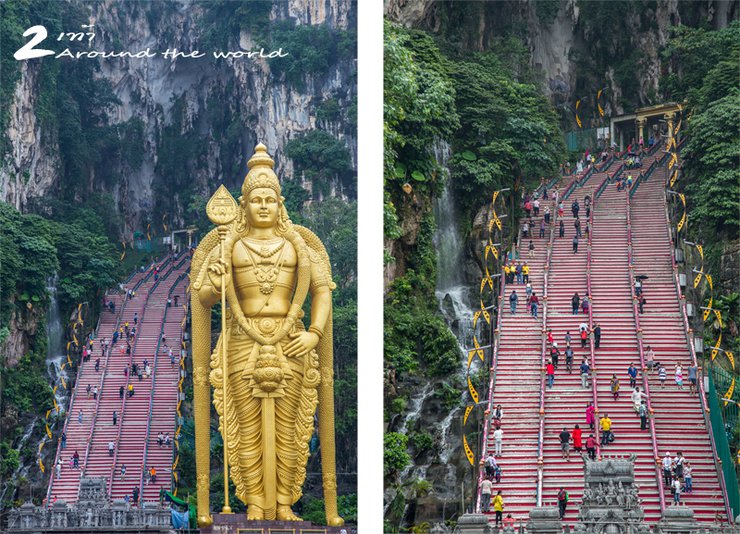
With only one day in Kuala Lumpur, where can you visit? Today, I have some places to recommend.
1. Istana Negara Palace




"Istana Negara Palace" is the new residence of the King of Malaysia, having relocated from its previous, smaller location in the city center. The palace now sits atop a hill overlooking Kuala Lumpur. The dome of the palace is gold, the official color of the Malaysian royal family. In front of the palace stands a flagpole. If the flag is raised to the top, it signifies that the King is in residence. The flag was indeed raised on the day of my visit.
Malaysia comprises 13 states, each traditionally ruled by a Sultan. Currently, only nine states have Sultans. Penang, Malacca, Sabah, and Sarawak do not have Sultans. Among the nine Sultans, one holds the position of Yang di-Pertuan Agong, the Head of State, for a five-year term. Upon completion of the term, another Sultan ascends to the position. This palace has been in existence for six years. The first Sultan to reside in this palace was the Sultan of Kedah. The current Sultan in residence is the Sultan of Terengganu.
2. Batu Caves


"Batu Caves" is a limestone cave located north of Kuala Lumpur. It is a Hindu religious site and the largest Hindu temple in Malaysia. The most notable feature is the large statue of Lord Murugan at the entrance of the cave. Lord Murugan is a Hindu deity and the brother of Lord Ganesha. However, it is unclear who is older, as there is no definitive evidence. According to the story, Lord Murugan is the son of Parvati and Shiva. Shiva's semen fell to the ground, but before it could reach the earth, a celestial bird caught it. The bird was instructed by Brahma to deposit the semen with a pure woman. The bird then deposited the semen in Parvati's womb, resulting in the birth of Lord Murugan. One interesting activity is climbing the 272 steps to reach Batu Caves. During the annual Thaipusam festival, similar to the vegetarian festival in Thailand, thousands of devotees participate in the event.
3. Merdeka Square




**Merdeka Square** is a significant landmark in Malaysia, where the country's independence was proclaimed. The signing of the agreement that freed Malaya from British rule took place in Malacca, while grand celebrations were held at Merdeka Square.
Colonized by Western powers for 446 years, Malaysia began with the Portuguese invasion of Malacca by sea. Subsequently, it was ruled by the Dutch and the British. On August 31, 1957, Malaysia regained its sovereignty from the British, marking the first time the Malaysian flag was raised at this square. "Merdeka" signifies independence. Within Merdeka Square, the historical Sultan Abdul Samad Building remains. Named after the Sultan of Selangor, it served as a government office during British rule but now houses the Supreme Court. The architecture is Moorish, and the 40-meter clock tower is colloquially known as "Big Ben of Malaysia." The Sultan Abdul Samad Building's construction used 3 million bricks imported from India.

Across from the Sultan Abdul Samad Building, the Victoria Fountain, built by the British to symbolize and honor Queen Victoria, stands as a testament to British influence. Notably, the British constructed similar fountains in other colonized cities, such as Malacca.
4. National Monument of Malaysia





The National Monument of Malaysia: A Tribute to Sacrifice and Unity
The National Monument, also known as the Tugu Negara, stands as a solitary testament to the sacrifices made by Malaysians in the pursuit of freedom and peace. This iconic landmark, unique in Malaysia due to the country's predominantly Muslim population and its aversion to idol worship, commemorates those who lost their lives in two pivotal events: World War II and the Malayan Emergency.
The monument, a bronze sculpture depicting seven figures, embodies seven key qualities: courage, leadership, sacrifice, strength, resilience, unity, and vigilance. Standing as the world's largest single-cast bronze sculpture, it was created in 1966 by Felix de Weldon.
Following the monument is the ASEAN Garden and the Tun Razak Monument, which commemorates Malaysia's second Prime Minister.
5. Petronas Twin Towers

The Petronas Towers, standing at 452 meters with 88 floors, are the tallest twin towers in the world and the 11th tallest buildings overall. They are connected by the world's highest skybridge. The exterior is constructed from glass and steel, while the interior design reflects Malaysia's aspirations for the future while preserving its national identity. However, the Petronas Towers' reign as the tallest buildings will soon be surpassed by the Thai Boon Roong Towers, a new twin-tower complex in Phnom Penh, Cambodia. Reaching a staggering height of 560 meters with 133 floors, the Thai Boon Roong Towers are expected to take 5 years to construct, with construction commencing around mid-2017.
The Petronas Twin Towers possess an undeniable charm during the evening hours, surpassing their daytime allure. The vibrant illumination cast upon the structures imbues them with an ethereal glow, as if they were emanating light themselves. The aesthetic impact is truly remarkable.
ลุงเสื้อเขียว
Tuesday, October 8, 2024 11:25 AM





















